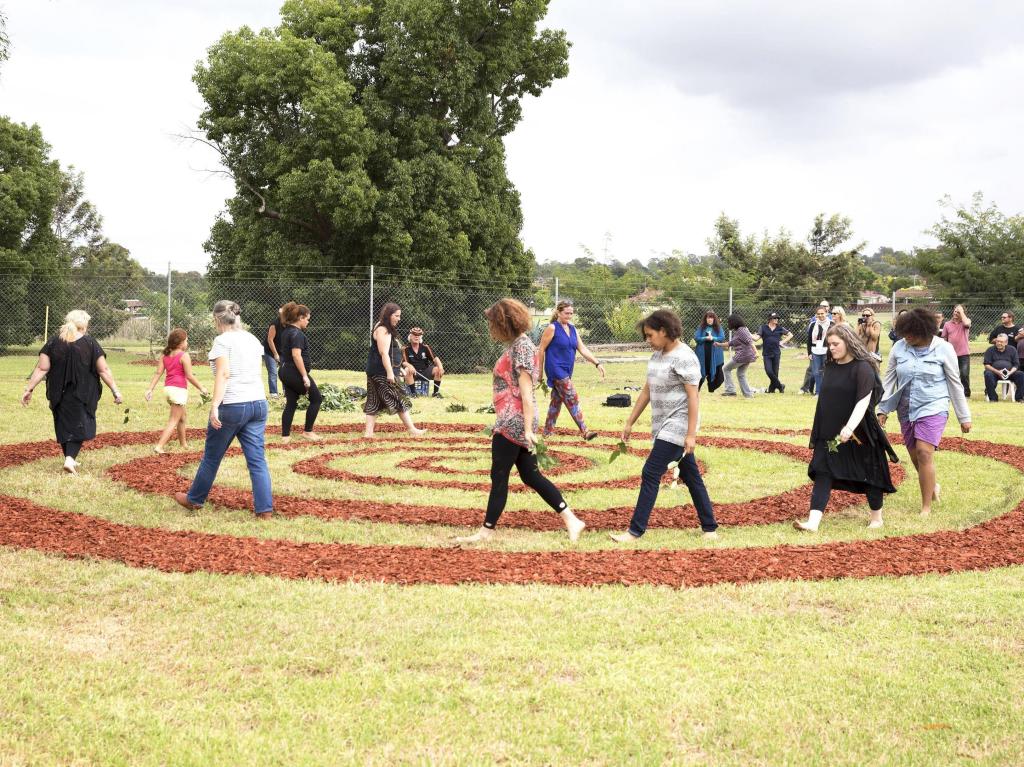Leanne Tobin, It Starts Here Now, 2015, performance documentation, Blacktown Native Institution Artist Camp #2, 2015. Image courtesy and © the artist. Supplied.
‘I genuinely believe that the greatest way to understand other people is getting the opportunity to walk in their shoes, to hear their stories. And when people hand over their stories to you, it’s an incredible responsibility, not only for them but for you as the artist,’ said artist Tony Albert.
When you collaborate, ‘you’ve got to understand that you’re the guest. You have to listen to what people want,’ he added.
Albert is currently developing a work for Ngara – Ngurangwa Byallara (Listen, hear, think – The Place Speaks), an arts project that acknowledges a significant Aboriginal site in Sydney’s western suburbs, the former Blacktown Native Institution.
Few outside the communities of Blacktown know of the cultural significance of this 1.5 square kilometres of grassland, lying only metres from the M7, which was awarded New South Wales Heritage Listing status in 2011.
Opened in 1823, the Blacktown Native Institution is one of the earliest colonial sites in Australia that symbolises the forced removal of children from their families. ‘We talk about the Stolen Generation, and these kids, they were the original stolen generation,’ said Darug Traditional Custodian Julie Clarke Jones.
For the past three years, the Blacktown Native Institution project has sought to improve the broader cultural understanding of the site and – perhaps more importantly – bring communities together to share their stories and heal.
Aboriginal communities and non-Aboriginal people are invited to come together for Ngara – Ngurangwa Byallara (Listen, hear, think – The Place Speaks) on Saturday 9 June to remember the history of the Blacktown Native Institution, understand the lives of the children who resided there, and participate in the important regeneration of the site.
Supported through a collaboration between Blacktown Arts Centre and the Museum of Contemporary Art’s C3West program, this year the project involves new commissions from Kuku Yalanji artist Tony Albert and Nyoongar artist Sharyn Egan, as well as Aboriginal theatre company Moogahlin Performing Arts, all of whom have worked closely with local Indigenous communities in the creation of artworks and installations.
Gifting memories to the children
Albert’s work is about healing the site. He has worked with Jones and local children to create a interactive artwork that reimagines the lives of ten children who lived at the Institution.
‘People will be encouraged to gift a memory to the reimagined children by writing it down on paper embedded with vegetation. The paper will be buried onsite and will heal the area. The objects I am making with the children can also possibly have a presence inside institutions, museums or galleries around Australia and the world. Great memories can be gifted and brought back to Country for the purpose of healing the site,’ said Albert.
‘The land actually needs to be healed, needs to be revegetated, not only with plants but with some heart and soul to go back to a time where it was very cherished and important.’
Working together towards this common goal is part of the strong sense of community empowerment underpinning the entire project.
‘The negativity that the community feels and understanding that is attached to the land, they wanted that rectified. My hope is that this is something that can do that, or at least start the process of reclaiming that site and giving it something very deserving of what that land is worth,’ said Albert.
Anne Loxley, Senior Curator of the C3West program, said everyone is working together in a process of ‘genuine exchange’ to create a project of local and national importance.
Ngara – Ngurangwa Byallara (Listen, hear, think – The Place Speaks) will acknowledge painful histories, and also create a space to include other stories outside of this colonial narrative and prepare for the future of the site.
Julie Clarke Jones said: ‘Nobody ever remembers pre-Blacktown Native Institution, it’s always about that. We think of it purely from a colonial perspective, from when the site was built and the Native Institution opened. But [for this project] we’ve been able to talk about other things that the site was used for in ceremony, and the other special places that are within that site and share that with the artists, which has been a really beautiful thing to be a part of.
‘I’ve always had a vision about that place and I’ve always carried the same sadness … When I think about that place I think about the children, what they were taken away from, what they lost, what they endured, and how it all ended in such a short period of time for them.
‘Most of them were Darug children, but a lot of them weren’t Darug children, and I guess as a Traditional Custodian, I have felt a real obligation to look after the spirit of those children as equally as we do our own.’
Visit mca.com.au to find out more.





